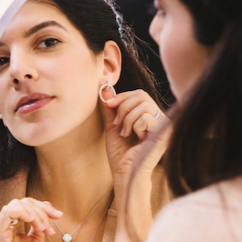Articles and News
How Jewelers Can Keep The Momentum Going | February 22, 2021 (0 comments)

Antwerp, Belgium—The diamond and jewelry industry did many things right in 2020, ultimately outperforming many other luxury sectors and avoiding the fates that industries like hospitality experienced. As noted in the 10th annual report on the global diamond industry, prepared by the Antwerp World Diamond Centre (AWDC) and Bain & Company, the industry at this moment is well positioned for the future.
But this moment also is a critical juncture for the industry, and its strategies now will determine how the industry fares in the future, says the report. Much is still in flux—and the report cautions that while the last quarter of 2020 began a revival, full recovery is not expected until 2022 – 2024.
“Even after the consequences of the pandemic are fully mitigated, industry players must continue to restructure their business models to align with long-term trends and operational realities. The industry needs to embrace digital technologies, explore new marketing concepts, and engage consumers differently to capitalize on long-term growth prospects,” says the report.
Related: Industry Handled 2020 The Right Way And Is Well Set Up To Forge Ahead
The pandemic accelerated structural changes in the diamond industry. E-commerce adoption increased in retail and expanded into B2B trading for rough and polished diamonds. The divergence between lower- and higher- quality diamonds deepened, with prices and volumes for high-quality diamonds recovering faster and stronger.
Here are some of the key areas where both retail jewelers and the B2B supply chain need to refine strategies to ensure continued growth:
1. Digital, physical, and “phygital.”2020 saw tremendous growth in online sales for the industry, in both wholesale and retail. In fact, business-to-business (B2B) was the big digital breakout news of the pandemic year with multipleplatforms starting or expanding rough and polished diamond trading.
B2C e-commerce also grew in 2020, with about 20% of retail sales occurring online. Major diamond jewelry retailers posted up to 60% to 70% year-over-year sales growth in their online channels.
But despite the increase in online sales and a strong preference for online research before making purchases, 90% - 95% of consumers (worldwide) still prefer to buy diamonds in brick-and-mortar stores, says the report. Consumers still value the opportunity to see and touch jewelry, and benefit from in-person advice and other personal services.
To create a meaningful shift toward digital channels, the industry needs to address several consumer concerns, says the report: improve trust (diamond certificates, warranties, reviews), enhance convenience (free delivery and returns or “try before you buy” programs) and provide additional discounts and promotions for online purchases.
2. Though better, marketing needs more improvement.Industrywide, marketing efforts need to be reinvented and increased, says the report. Despite current efforts, diamond marketing spend still is roughly 1% to 2% of industry revenue, which lags the average luxury goods marketing spend of 6% to 8%.
Marketing must address generational shifts and increased competition for consumers’ share of wallet. Generation Z will be both a growth engine and a change agent for the industry, with its evolving preferences, purchasing behaviors, and sustainability agenda.
In 2020, consumers’ inability to travel, dine out, or enjoy other experiential pleasures benefited jewelry sales, but as those capabilities return, jewelry must remain competitive to keep market share. Future marketing campaigns should connect diamonds to additional life moments, expanding the market (and consumers’ emotional connection to diamonds) beyond marriage. The diamond story needs to become more personal and engaging, through storytelling, social media, and customization.
Retailers need to invest in omnichannel and phygital capabilities to match new purchasing preferences, and manufacturers should promote sustainability practices that consumers care about.
Lab-grown price delta grows. Continued advances in technology contributed to double-digit growth in production and lower retail prices for lab-grown diamonds in 2019 and 2020, says the report. The price differential between natural and lab-grown fancy color diamonds is particularly notable, up to 10 times. Additionally, major fashion jewelry retailers are adding lab-grown diamonds to their product offerings, further positioning the category into the fashion jewelry segment and making it accessible to a wider range of price-sensitive consumers. (Editor’s note: this also presents an opportunity for better jewelers to position natural diamonds as a trade-up option as those consumers grow more affluent.)
Sustainability, transparency, and social welfare are priority issues. Thesewere growing issues in previous years but now they are firmly top-of-mind for consumers—as well as investors and the entire value chain, says the report. Younger consumers especially say sustainability is part of their decision-making process and could influence whether they buy diamond jewelry. Companies across the value chain are responding with a range of initiatives to tackle emissions and water consumption, increase diversity and support for local communities, and improve diamond traceability.
What the future should hold. 2021 started strong and builds on 2020’s good strategies. As mentioned, the industry did many things right in 2020 and the long-term outlook for the diamond market remains positive. Midstream inventories are at healthy levels and better aligned with consumer demand, and the B2B sector made solid digital and partnership advances. Most miners reported 5%–8% rough diamond price and sales improvement in January.
That said, however, there is still a lot of economic uncertainty ahead. As stated earlier, a full recovery is not expected until 2022-2024.The current crisis still could be more severe than 2009’s financial crisis, and a double-dip recession is possible. Three factors will impact the pace and shape of the recovery: epidemiology, government policy response, and consumer response.







